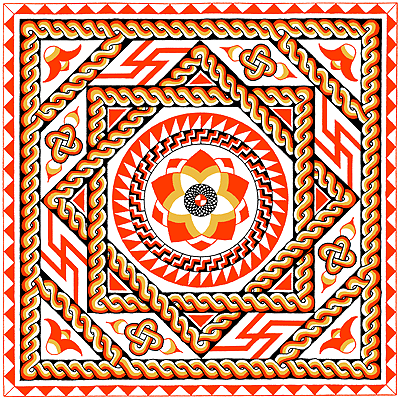
RBH Home
Maps & Travels
Articles
Legends
Towns & Villages
Castles & Houses
Churches
Biographies
Gentry
Family History
Odds & Ends
Mail David
Lower Basildon Roman Villa
Basildon, Berkshire
 While
constructing the Great Western Railway line at Lower Basildon
in 1839, workmen found what appears to have been the remains of a
relatively modest, though luxuriously fitted out, Roman Villa of several
rooms. It was probably occupied by a middle class family farming the
surrounding countryside. The major finds were two superb mosaic floors
which the navies almost immediately proceeded to smash to pieces. One was
apparently much damaged in antiquity, the second complete mosaic was
fortunately drawn in some detail just prior to its destruction by the
antiquarian, Charles Roach-Smith. Berkshire is distinctly lacking in Roman
mosaics, so it is particularly gratifying to know that this interlocking
squares pattern was laid by the best mosaicists in the country: the
so-called Central Southern Group of artists, probably working out of
Winchester or Chichester in the 4th century. Recent excavations indicate
that there is little left today, the main villa building being almost
entirely covered by the railway. Some substantial outbuildings have
survived, possibly barns, slaughter houses or kitchens; as well as an
impressive array of ditched fields and paddocks. The main ditch around the
side was some three metres deep. The site was occupied from the 1st to the
4th centuries and perhaps rebuilt twice. It has produced numerous finds:
much building material (roof and floor tiles, concrete flooring, etc),
bones, oyster shells, coins, pots, mortaria, wine jars, Oxford and Samian
finewares and even a barrel padlock. It was apparently built next to an
ancient Roman crossing point over the Thames, remembered as ‘Bestle-ford,’
the earliest known name for the village.
While
constructing the Great Western Railway line at Lower Basildon
in 1839, workmen found what appears to have been the remains of a
relatively modest, though luxuriously fitted out, Roman Villa of several
rooms. It was probably occupied by a middle class family farming the
surrounding countryside. The major finds were two superb mosaic floors
which the navies almost immediately proceeded to smash to pieces. One was
apparently much damaged in antiquity, the second complete mosaic was
fortunately drawn in some detail just prior to its destruction by the
antiquarian, Charles Roach-Smith. Berkshire is distinctly lacking in Roman
mosaics, so it is particularly gratifying to know that this interlocking
squares pattern was laid by the best mosaicists in the country: the
so-called Central Southern Group of artists, probably working out of
Winchester or Chichester in the 4th century. Recent excavations indicate
that there is little left today, the main villa building being almost
entirely covered by the railway. Some substantial outbuildings have
survived, possibly barns, slaughter houses or kitchens; as well as an
impressive array of ditched fields and paddocks. The main ditch around the
side was some three metres deep. The site was occupied from the 1st to the
4th centuries and perhaps rebuilt twice. It has produced numerous finds:
much building material (roof and floor tiles, concrete flooring, etc),
bones, oyster shells, coins, pots, mortaria, wine jars, Oxford and Samian
finewares and even a barrel padlock. It was apparently built next to an
ancient Roman crossing point over the Thames, remembered as ‘Bestle-ford,’
the earliest known name for the village.
Based on the work
of Charles Roach Smith (1839) & Channel Four's Time Team (2001)
